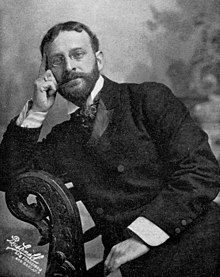Albert Abrams
| Albert Abrams | |
|---|---|
 |
|
| Born | December 8, 1863 |
| Died | January 13, 1924 (aged 60) |
| Nationality | American |
| Occupation | Doctor |
| Known for | Claiming to be able to cure almost any disease |
Albert Abrams (December 8, 1863 – January 13, 1924) was an American doctor, well known during his life for inventing machines which he claimed could diagnose and cure almost any disease. These claims were challenged from the outset. Towards the end of his life, and again shortly after his death, many of his machines and conclusions were demonstrated to be intentionally deceptive or false.
Albert Abrams was born in San Francisco December 8, 1863, although different other dates have also been reported . On October 8, 1878 he inscribed at Medical College of the Pacific, worked as an assistant of Prof. Douglass and Prof. Hirschfelder, and got a medical degree on October 30, 1881. Then he went to Heidelberg, Germany, and graduated there in November 1882 before undertaking further studies in London, Berlin, Vienna, and Paris. According to Wilson , Albert Abrams was awarded an M. D. by the Cooper College in 1883. He served on the teaching staff of the College for a total of fourteen years - five years (1885-1889) as Demonstrator of Pathology; four years (1890-1893) as Adjunct to the Chair of Clinical Medicine and Demonstrator of Pathology; and five years (1894-1898) as Professor of Pathology. He was elected vice-president of the California State Medical Society in 1889 and was made president of the San Francisco Medico-Chirurgical Society in 1893. In the beginning of the 1900s he had become a respected expert in neurology. From 1904 he was president of the Emanuel Polyclinic in San Francisco. Albert Abrams published numerous books from 1891 to 1923 . He died January 13, 1924, from a broncho-pneumonia in San Francisco.
Abrams was accused of fraudulently claiming a medical qualification from the University of Heidelberg; However documents from Archive of University Heidelberg confirm that Albert Abrams received a medical degree there on 21 November 1882.
In Abrams' view, American medicine was dominated by physicians with excessive admiration for German doctors and researchers. In earlier writings, he aroused the anger of physicians by dubbing them Dr. Hades or Dr. Inferior, by comparing their looks to typhoid and other germs, and by making fun of various abstruse therapies that at the time were considered "scientific" by the medical establishment. In a poem that he wrote on balloon therapy, for instance, the doctors take their patients up in the air but do not know how to bring the balloon down again. The poem ends with the lines: But they never came back. That's why we confess / Aëronautic therapy is not a success.
...
Wikipedia
